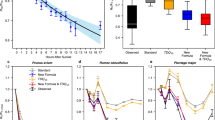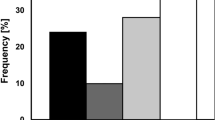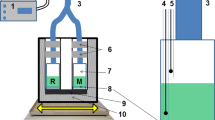Abstract
I DESIRE, with your permission, to give publicity in the columns of NATURE to the results of some observations on the above subject, communicated by me to the Royal Society of Victoria on June 13. As the facts to be mentioned are not referred to in Sachs' “Text-book of Botany”, in the dictionaries of chemistry of Watts and Wurtz, or in recent volumes of the Journal of the Chemical Society or the Chemisches Centralblatt, I presume that they are little, if at all, known to botanists. I have found, first about nine years ago, and have more systematically observed lately, that fresh sections of many fruits, such as the apple and pear, and other vegetable structures as the potato, turnip, &c., give the reactions considered to be characteristic of ozone, viz., causing separation of iodine from iodide of potassium, and turning tincture of guaiacum blue, the intensity of these reactions varying in different samples of the vegetable substances, but depending mainly on their comparative freshness. I have further found that the same structures contain a substance which acts as an Ozonträger, to use Schönbein's expression, a substance which transfers ozone from peroxide of hydrogen and similar articles. This is shown by the fact that if the guaiacum is not blued at all, or only to a slight extent, the blue colour becomes very marked when a drop of ethereal solution of peroxide of hydrogen is added. I infer from these observations (1) that the oxygen inhaled by living plants, and even by pulled fruits for a time, is ozonised or rendered active, probably by entering into loose combination, as is the case with the oxygen in the blood of animals; and (2) that it is probable, though not proved, that the ozone-transferring substance existing in almost every fresh vegetable structure is that with which it is loosely combined, as the oxygen in the blood is with the hæmoglobin of the red corpuscles, which is a very active Ozonträger. This element in plants is gradually destroyed as decay comes on, and ceases to perform its ozone transferring function when the fruit, &c., containing it is cooked. It is not chlorophyll, as is shown by its situation, and it seems to be intimately associated with the vascular tissue. From analogy with the animal substances hæmoglobin, fibrin, myosin, &c., which have a similar action, it may be presumed to be proteinaceous, though I am unable to indicate its chemical and other characters more exactly. The interesting analogy between the respiratory functions of animals and plants indicated by these observations will, I hope, be considered a sufficient excuse if I ask you to insert this short summary of my paper which you will receive at the same time.
This is a preview of subscription content, access via your institution
Access options
Subscribe to this journal
Receive 51 print issues and online access
$199.00 per year
only $3.90 per issue
Buy this article
- Purchase on Springer Link
- Instant access to full article PDF
Prices may be subject to local taxes which are calculated during checkout
Similar content being viewed by others
Author information
Authors and Affiliations
Rights and permissions
About this article
Cite this article
JAMIESON, J. The Respiration of Plants. Nature 18, 539–540 (1878). https://doi.org/10.1038/018539b0
Issue Date:
DOI: https://doi.org/10.1038/018539b0
Comments
By submitting a comment you agree to abide by our Terms and Community Guidelines. If you find something abusive or that does not comply with our terms or guidelines please flag it as inappropriate.



